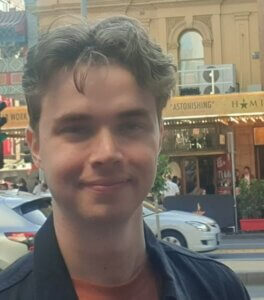Organizing Chaos
Simulation Expert Merges Technology With Local Knowledge Of Wildfire
BY DYLAN BRUCE

Rohan Fisher is one of northern Australia’s foremost experts in fire simulation and is an advocate for the technology’s use as a powerful educational tool.
Working as a fire researcher with Charles Darwin University, Fisher develops fire-simulation technologies for use by those managing land in Northern Australia.
“I see the fire simulations I have developed as serious games and encourage people to play with the complex array of variables affecting fire behaviour,” says Fisher.
Fire simulations can be used to output a visualisation of a fire’s likely spread, and this can be projected onto a 3D printed landscape to further enhance how the information is conveyed. As the effects of climate change intensify, Fisher says effective and informed fire management will be an important part of responding to the increased threat of fires.
“Throughout remote Australia, increasing extreme fire weather is producing severe bushfires,” says Fisher.
“Good fire management in these landscapes is urgently needed, and, in the northern tropical savannas, Indigenous-led fire management at the landscape scale is already producing some of the world’s best fire management outcomes.”
Fisher has worked closely with Indigenous communities in Northern Australia to create fire simulations that visualise how old and new ways of managing fire affect the environment, providing them with an engaging way to share local fire management knowledge and pass on cultural experience to the next generation.
“Each fire simulation is developed in collaboration with the Indigenous groups for their land, to support their specific fire training and outreach needs,” says Fisher.
“The fire management stories the simulations are used to tell is entirely up to the groups themselves.”
Fisher has supported communities across Northern Australia and Eastern Indonesia to bring together their local knowledge with the latest technologies, such as satellite data, to safely and effectively manage fires.
“My simulations allow users to visualise how fire behaviour is affected by interactions between landscape and fire weather variables and facilitates that communication of goals between a culturally diverse set of land managers,” says Fisher.
With wide savannas and a small population, fire simulations for Northern Australia differ from those used in European, North American, or even Southern Australian contexts. Fisher says that this biome requires a specific focus on the propagation and extinguishment of fire to support land management objectives, rather than primarily supporting emergency responses. While fire simulations are a valuable tool, it’s important to remember that they aren’t a crystal ball – a simulation is limited by the quality of the data with which it is made, and even good information isn’t a guarantee of accuracy.
“Even when good data is available, accurate spread prediction remains problematic due to the uncertainties associated with variations in fuel, weather, and topography and the complex interaction between these variables,” says Fisher.
“That’s why my simulation work aims to broadly support fire management discussion rather than explicitly predicting outcomes.”
 Dylan Bruce is a writer from Melbourne, Australia, who is passionate about the impacts of fire on the environment and society.
Dylan Bruce is a writer from Melbourne, Australia, who is passionate about the impacts of fire on the environment and society.

